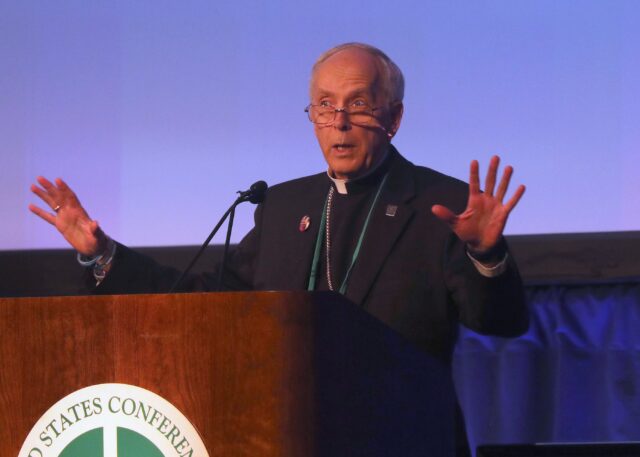
BALTIMORE — The chair of the U.S. bishops’ Committee on Migration said he was “very optimistic” that efforts to resolve backlogs for religious worker visas were moving forward, thanks to potential new legislation and dialogue with the current presidential administration.
Bishop Mark J. Seitz of El Paso, Texas, provided an update Nov. 11 during an afternoon session of the U.S. Conference of Catholic Bishops’ Fall 2025 Plenary Assembly, which is taking place Nov. 10-12 in Baltimore.
The issue of religious worker visas highlights the perfect storm created by a downturn in priestly and religious vocations among U.S. Catholics, and the entrenched challenges of the nation’s immigration laws and policies.
For religious workers, “the clock starts ticking” the moment they enter the U.S., the nonprofit Catholic Legal Immigration Network, or CLINIC, said on its website.
The R-1 designation for religious worker status is valid for two and a half years, with a possible extension of the same length — providing a potential five years of authorized stay in the U.S.
Once the five years have ended, religious workers can pursue one of three options: change to either a student (F-1) or specialty occupation (H-1B) visa; leave the U.S. for at least a year before once again becoming eligible for another R-1 visa; or file a petition, through their diocese or religious order, to gain lawful permanent residency (known as a “green card”).
But changes in the State Department’s monthly visa bulletin — particular in the spring of 2023 — have snarled the processing of applications for lawful permanent residency for religious workers, leaving “many religious communities across the country being in dire straits as their religious workers have been forced to leave,” CLINIC said on its website.
During the USCCB’s spring 2024 annual meeting, Bishop Seitz observed that the religious worker visa issue “is only expected to worsen with time, if not addressed” — especially since close to 90% of the nation’s Catholic dioceses rely on foreign-born clergy and religious.
“This is simply not sustainable for our ministries — and it is especially devastating for parishes that will be left without a pastor when he is forced to depart the country at the end of his R-1 visa,” Bishop Seitz told the assembly.
Addressing the attendees Nov. 11, Bishop Seitz — noting that “there’s much that certainly could be said about migration in this moment” — pointed to June 2025 data from U.S. Citizenship and Immigration Services indicating that “a priest or other religious worker who begins applying for a green card today is looking at a wait of at least 30 years.”
“When we speak about our legal immigration system, this is a perfect example of why reform is so badly needed,” he said.
One possible step toward such reform may lie in the Religious Workforce Protection Act, identical bills introduced in early April in both the Senate and the House, and described by CLINIC as “a short but powerfully impactful piece of legislation.”
According to CLINIC, the “three key parts” of the act would ultimately work to enable religious workers to file extensions while their green card applications are processed, preventing the need to leave the U.S. for a year and apply for a new R-1.
The act “would also provide more job flexibility for religious workers throughout the permanent residency process,” said CLINC on its website.
Speaking at the Nov. 11 session of the USCCB plenary, Bishop Seitz said he was “very pleased to see the introduction” of the legislation in Congress “following months of engagement with its bipartisan co-sponsors.”
Since the RWPA’s introduction to lawmakers, he said, “our efforts have largely focused on increasing support for it within both chambers of Congress.”
Bishop Seitz added that “our interfaith partners have been instrumental to this effort.”
At the same time, he said, “while the number of co-sponsors has continued to grow, positive legislative action of any kind remains a difficult endeavor.”
Bishop Seitz said that “beyond advocacy with Congress, engagement with the administration on this issue is also ongoing.”
“With the attention being given to this situation” by Secretary of State Marco Rubio “and others,” said Bishop Seitz, “we are hopeful to see positive developments in the very near future — very optimistic.”
He expressed his gratitude to those who have “advocated on this issue, including in a particular way” outgoing USCCB president Archbishop Timothy P. Broglio of the U.S. Archdiocese for the Military Services, who completes his three-year term at the close of the fall 2025 assembly and will be succeeded by Archbishop Paul S. Coakley of Oklahoma City.
Bishop Seitz also commended “the good efforts of our conference staff, along with the Catholic Legal Immigration Network, or CLINIC, who have been working diligently on these challenges.”








